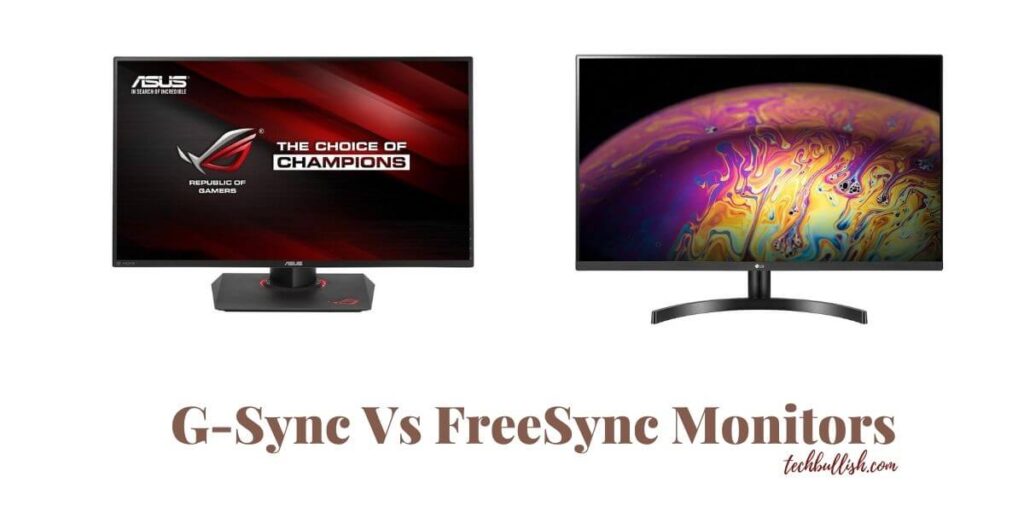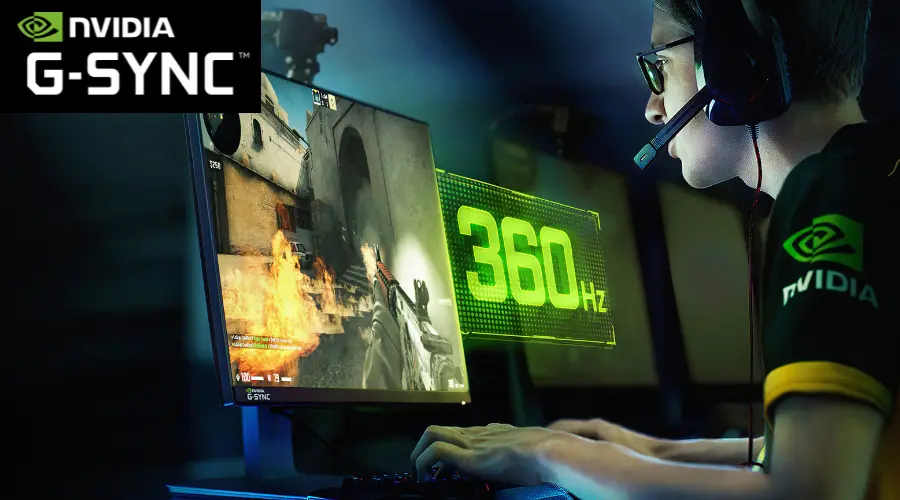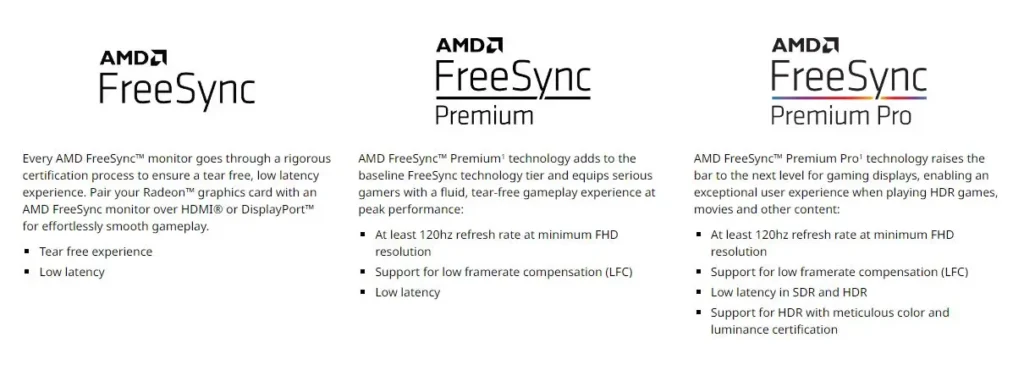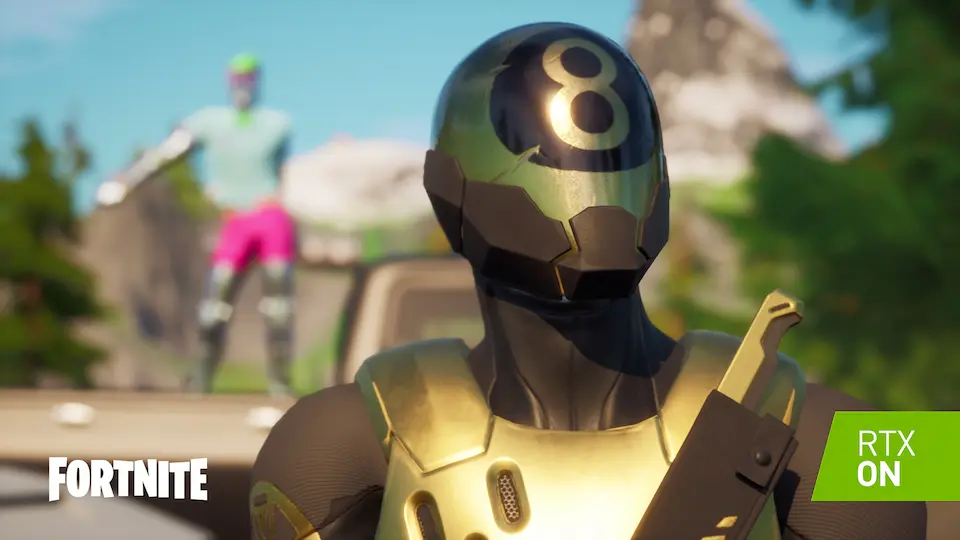If you have purchased a high-quality graphics card and still see stuttering or screen tearing with visible artifacts, it is a bad experience.
It is happening due to the mismatch of frames being transferred between your Gaming Monitor and your Graphics Card.
To solve this issue different graphics card manufacturers came up with variable refresh rate technologies like G-Sync and FreeSync.
In this post, I would discuss the comparison of G-Sync vs FreeSync and go through their tiers, advantages, and disadvantages to find which is better.

Let’s get started!
G-Sync vs FreeSync
| NVidia G-Sync | AMD FreeSync | |
| Created by | Nvidia | AMD(Advanced Micro Devices, Inc.) |
| Types | G-Sync, G-Sync Compatible, G-Sync Ultimate | AMD FreeSync. AMD FreeSync Premium, AMD FreeSync Premium Pro |
| HDR Support | Supported in G-Sync Ultimate | Supported in AMD FreeSync Premium Pro |
| Price | Premium as compared to standard monitors | Same as standard monitors |
| User | People who use Nvidia GeForce GPUs would use G-Sync monitors. | People who use AMD Radeon GPU would use FreeSync monitors. |
| Release | 2013 | Initial Release on Mar 2015, Stable Release on Jan 2017 |
| Supported Displays | G-Sync supported monitors | FreeSync supported monitors |
What is G-Sync? (By Nvidia)

G-Sync is a technology by Nvidia made specially to sync with the monitors and provide a smooth variable refresh rate gameplay that does not have any screen tearing issue or any input lag with it. This technology helps to sync up the monitors for the systems that use Nvidia GeForce Graphics Cards.
G-Sync-supported monitors fall under one of these three categories:
G-Sync Compatible
The G-Sync Compatible option for the monitor provides the basic feature for any gaming monitor for a good experience.
The monitor with G-Sync Compatible option has an excellent variable refresh rate, so it means the display can adapt to the variable refresh rate that the game settings and the graphics card request to render.
The G-Sync Compatible also solves the fundamental problem of stuttering for high graphics in-game and tearing the graphics in-game.
Thus you will get a good experience with G-Sync compatible monitor if you use a GeForce Graphics Card.
G-Sync (Regular One)
G-Sync monitors have the essential features as the G-Sync compatible ones. The basic issues like the stuttering and the tearing get resolved.
Also, you get the input lag solved with G-Sync monitors. G-Sync is better to have as in FPS games, and the input lag matters much.
G-Sync Ultimate
G-Sync Ultimate is the best option in the G-Sync monitor range.
The monitor compatible with G-Sync ultimately has the best offerings from NVidia optimization.
Here, you get all the premium features of the G-Sync monitors.
In addition, in the ultimate version, you get the Lifelike HDR graphics rendering in your games.
You would like to play games in HDR, which improves gaming graphics with lifelike colors. The enhancement this provides to the gameplay is unbelievable.
Suppose you compare a monitor without G-Sync Ultimate and another monitor with this feature enabled.
In that case, you will see a noticeable amount of differences and enjoy your game more.
To know more about G-Sync check here.
G-Sync Enabled Desktop GPU
| Kepler | Kepler (refresh) | Maxwell | Pascal | Volta | Turing | Ampere |
|---|---|---|---|---|---|---|
| GeForce GTX 650 Ti Boost | GeForce GTX 760 | GeForce GTX 745 | GeForce GT 1030 | Titan V | GeForce GTX 1650 | GeForce RTX 3070 |
| GeForce GTX 660 | GeForce GTX 770 | GeForce GTX 750 | GeForce GTX 1050 | GeForce GTX 1660 | GeForce RTX 3080 | |
| GeForce GTX 660 Ti | GeForce GTX 780 | GeForce GTX 750 Ti | GeForce GTX 1050 Ti | GeForce GTX 1660 Ti | GeForce RTX 3090 | |
| GeForce GTX 670 | GeForce GTX 780 Ti | GeForce GTX 950 | GeForce GTX 1060 | GeForce RTX 2060 | ||
| GeForce GTX 680 | GeForce GTX Titan | GeForce GTX 960 | GeForce GTX 1070 | GeForce RTX 2060 Super | ||
| GeForce GTX 690 | GeForce GTX Titan Black | GeForce GTX 965M | GeForce GTX 1070 Ti | GeForce RTX 2070 | ||
| GeForce GTX Titan Z | GeForce GTX 970 | GeForce GTX 1080 | GeForce RTX 2070 Super | |||
| GeForce GTX 970M | GeForce GTX 1080 Ti | GeForce RTX 2080 | ||||
| GeForce GTX 980 | Titan X | GeForce RTX 2080 Super | ||||
| GeForce GTX 980M | Titan XP | GeForce RTX 2080 Ti | ||||
| GeForce GTX 980 Ti | RTX Titan | |||||
| GeForce GTX Titan X |
To check the Latest monitors that support G-Sync, NVidia has a great resource page.
What is Freesync? (By AMD)
FreeSync is the technology from AMD to remove stuttering or tear during gameplay. The FreeSync makes the monitor tuned to the AMD Radeon Graphics card systems.

The FreeSync technology improves gaming a lot and works well with AMD Radeon Graphics cards.
There are also several tiers of FreeSync offerings to monitors and more premium offerings added to it.

AMD FreeSync (Regular One)
The monitors with AMD FreeSync go through a certification process that ensures no tearing and stuttering of the images during gaming.
Also, the monitors work in low latency mode.
Even with the basic AMD FreeSync, the games work great, and you will feel no problems while playing at a higher refresh rate.
The FreeSync Premium monitors have all the essential features that the AMD Freesync provides, like zero tearing and stutterings.
In addition to that, the AMD FreeSync Premium takes the gaming experience to the next level.
With this version of FreeSync, you will get a minimum of 120 Hz refresh rate at a Full HD (1920*1080) resolution.
The low latency and low framerate compensation work flawlessly.
AMD FreeSync Premium helps to get a smooth and excellent gaming experience.
You have already got a great gaming experience from the AMD FreeSync Premium.
However, they have raised the gaming experience further with its AMD FreeSync Premium Pro version.
With the pro version, the AMD FreeSync Pro, they have added HDR and SDR support for gaming.
The colors come out excellent like in movies, and you would get a cinematic feel.
Even the Framerates are maintained, and the low latency is maintained at HDR and SDR.
Compatible GPUs with AMD FreeSync
Compatible GPUs include all AMD Radeon™ graphics cards beginning with Radeon™ RX 200 Series, released in 2013, and all newer Radeon consumer graphics products that use GCN 2.0 architecture and later.
Other GPUs, such as the Nvidia GeForce 10 series and newer, that support DisplayPort Adaptive-Sync, are also expected to work with AMD FreeSync Technology. (Source: AMD)
Advantages and Disadvantages of NVidia G-Sync
Here are the advantages and Disadvantages below for NVidia G-Sync technology:
Advantages
1. No screen tearing is observed.
2. No stutters and ghosting at all during gaming.
3. Gaming does not have any noticeable input lags. Everything feels smooth frame by frame.
4. Colors look vibrant due to their High Dynamic range and are very much enjoyable. (Available for G-Sync Ultimate Versions)
Disadvantages
1. G-Sync Supported Monitors are expensive.
Advantages and Disadvantages of AMD FreeSync
Here are the advantages and Disadvantages below for AMD FreeSync technology:
Advantages
1. Screen Tearing issue is completely solved with FreeSync.
2. Input lag is not there.
Disadvantages
1. We see Ghosting on FreeSync Monitors. However, they are fixed in the premium versions of FreeSync.
Should I use G-Sync for competitive gaming?
G-Sync-enabled monitors are great for Competitive gaming. This technology provides smooth frames during gaming as it syncs your Nvidia graphics card with your monitor’s refresh rate.
Does FreeSync Monitor work with Nvidia Graphics Cards?
Nvidia Graphics Card does work well with FreeSync Enabled monitor if you keep the FreeSync Turned off.
It will work well except it would not be able to use the functionality of the Freesync technology as it can work with G-Sync Enabled Monitors.
Are G-Sync and FreeSync the same?
G-Sync And FreeSync, though are very similar technology but are created by different companies.
They are developed to solve a similar problem. G-Sync is developed by NVidia and FreeSync is developed by AMD.
In terms of performance, you will find the G-Sync is delivering a more consistent stutter-free, and great gaming experience.
What’s better FreeSync or G-Sync?
G-Sync is from NVidia and FreeSync is from AMD. Both are good in their perspective. You need to look at what your monitor is compatible with.
This will ensure to get most of your Graphics Card.
If you have a G-Sync Enabled Monitor and use it with an NVidia Graphics card, it will be better.
It is the same as using FreeSync Monitor with AMD Radeon Graphics Card.
If you use these for gaming purposes, they are almost similar. Previously, the Nvidia ones used to perform far better than AMD ones.
But, still, I would give G-Sync a lead as Most of the games are well optimized and perform well with them.

Conclusion
Let’s conclude the post on G-Sync vs FreeSync!
The FreeSync technology is from AMD, and the G-Sync is from NVidia.
Both technologies are outstanding and must-have if you want a good gaming experience with your graphics card at a higher refresh rate.
The FreeSync technology works better with the systems that use AMD Radeon Graphics Cards.
The G-Sync technology works well for systems with the NVidia GeForce Graphics card.
I hope you enjoyed reading the post.
References:
- NVidia Official Website: https://www.nvidia.com/en-us/geforce/products/g-sync-monitors/
- AMD Official Website: https://www.amd.com/en/technologies/free-sync

I’m Anirban Saha, Founder & Editor of TechBullish. With a B.Tech in Electronics and Communication Engineering, and 6+ years of experience as a software developer, I have expertise in electronics, software development, gadgets, and computer peripherals. I love sharing my knowledge through informational articles, how-to guides, and troubleshooting tips for Peripherals, Smart TVs, Streaming Solutions, and more here. Check Anirban’s Crunchbase Profile here.
